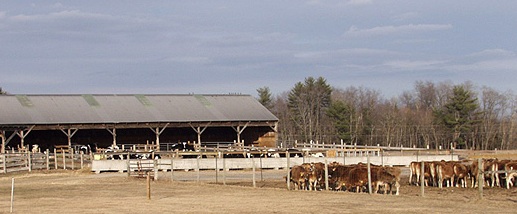
 June 5, 2008, Durham, N.H. –
June 5, 2008, Durham, N.H. –
University of New Hampshire researchers have received a grant to study
UNH’s organic dairy research farm as a sustainable closed agroecosystem.
June 5, 2008, Durham, N.H. – University of New Hampshire researchers have received a grant to study UNH’s organic dairy research farm as a sustainable closed agroecosystem.
 The $380,000, three-year grant – from the U.S. Department of Agriculture's Sustainable Agricultural Research and Education (SARE) program – aims to explore whether closing energy and nutrient cycles could help small family dairy farms in the Northeast survive economic vulnerabilities.
The $380,000, three-year grant – from the U.S. Department of Agriculture's Sustainable Agricultural Research and Education (SARE) program – aims to explore whether closing energy and nutrient cycles could help small family dairy farms in the Northeast survive economic vulnerabilities.
The study comes as rising energy, feed and capital investment costs shrink the already narrow profit margin of dairy agriculture in the Northeast, threatening the regional sustainability of the industry.
“In a closed system, the only thing leaving the farm is the milk,” says John Aber, professor of natural resources at UNH and the principal investigator on the grant. “The goal is to see whether we can have a closed-nutrient-cycle and energy-independent organic dairy.”
In a closed system, for instance, cow manure fertilizes the fields on which the herd grazes. Sawdust from woodlands on UNH’s 300-acre farm in Lee might be utilized for animal bedding, which is becoming increasingly expensive; woodlands might also provide fuel for small cogeneration plants. Methane digestion could produce usable methane from manure.
The first step for Aber, his faculty co-investigators, and UNH students who are working on the project is to assess energy and nitrogen budgets and balances. Nitrogen, he says, is the nutrient more critical to plant growth in the Northeast than any other; it comes from rainfall but can also be replaced by legumes like soybeans or clover.
“If you want to maximize dairy production and dairy output, you need to replace the nitrogen leaving the farm in milk,” he adds.
In the second and third years of the grant, the researchers will look at alternative ways to close the energy and nutrient cycles.
This past spring, five UNH undergraduates and a graduate student worked with Aber to study nitrogen flows and energy inputs and outputs. Results of those studies suggested that both energy independence and a closed nitrogen system could be achieved through intensive management of manure; changing the bedding method of the farm’s 40 cows; increasing the cows’ time on pasture; and growing grain, hay bedding and silage on-site instead of purchasing them from external sources.
This research will point UNH and organic dairy farmers from around the Northeast toward alternative farm management practices that could lead to more stable economic outcomes for small family farms.
“We’re moving toward a sustainable, closed system,” says Aber, “and toward best-practices to achieve that goal.”
Such an ecosystem-level approach to a commercial organic dairy production is unique, at least in the United States, where UNH’s organic dairy farm is the first commercial-scale research organic dairy. Aber and co-investigator William McDowell, also a professor of natural resources, bring to the project forest ecosystem experience as investigators on the National Science Foundation’s Long-Term Ecological Research (LTER) program.
Other co-investigators are associate professor of hydrogeology Matt Davis, Charles Schwab, professor of animal and nutritional sciences and a leader in the founding of the organic dairy, and organic dairy project director Kevin Brussell.
“The synergy of ecosystems expertise and dairy expertise is far greater than the sum of its parts,” says Aber.
“Family dairy farms are a vital part of the landscape and legacy of the Northeastern United States,” says UNH chief sustainability officer Tom Kelly, who conceived of this project. “This research will help small farmers in this region make informed decisions in the face of an uncertain energy and economic future and contribute to a more resilient food system.”